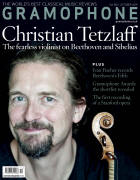Texte paru dans: / Appeared in: |
|
|
Outil de traduction (Très approximatif) |
|
|
Reviewer:
Charlotte Gardner If you regard yourself as a fairly seasoned and knowledgeable listener of Baroque music, then you may find the premise of ‘Bach & Co’ a slightly outdated one: that many people today believe Bach to have been the only outstanding composer of his time, whereas in fact Bach himself thought highly of his contemporaries and copied, arranged and performed their compositions. We’re even informed that ‘Georg Philipp Telemann is now gradually becoming much better known’. Still, focus instead on the charmingly performed, multi-composer programme containing a nice balance of the familiar (Bach’s A minor Violin Concerto and JG Graun’s Concerto in C for violin and recorder) and the slightly less so, and there’s plenty to recommend about this disc. In fact, I’ll begin with the work which really none of us will have heard, because it’s a world-premiere recording: a skillfully written, galant-style Violin Concerto in G minor by one of the album’s genuinely still-obscure names, practising lawyer turned composer Christoph Förster, who as a violinist led the Sachsen-Merseburg Hofkapelle after the departure of Graun in 1732. This is sprightly in the outer movements – the opening Andante coloured by major-key interludes, before the Allegro finale flips things around to become a joyful G major controlled dash coloured by minor keys only briefly – over which the soloist’s lines enable Noally to show his capacity for lyricism across bubbling strings and virtuoso passagework, and the musicians of Les Accents an equal opportunity to show the polished silkiness and tight ensemble-playing with which they deliver their own bouncing rhythmic energy. Try from 1'42" in the finale to hear what I mean from all parties. The stately, pining slow movement is equally effective. Les Accents’ sound also works beautifully for Telemann’s Concerto for violin and traverso in E minor, attractively softening the corners of a work that can sometimes end up sounding rather too angular; the first Adagio’s lyrical interplay between Noally and flautist Jean Bregnac is especially lovely, as is the one between them and the ensemble’s soft background pizzicato. In short, there’s lots to enjoy here. |
|




